ECU KIA Sorento 2009 2.G Owner's Manual
[x] Cancel search | Manufacturer: KIA, Model Year: 2009, Model line: Sorento, Model: KIA Sorento 2009 2.GPages: 327, PDF Size: 5.03 MB
Page 14 of 327
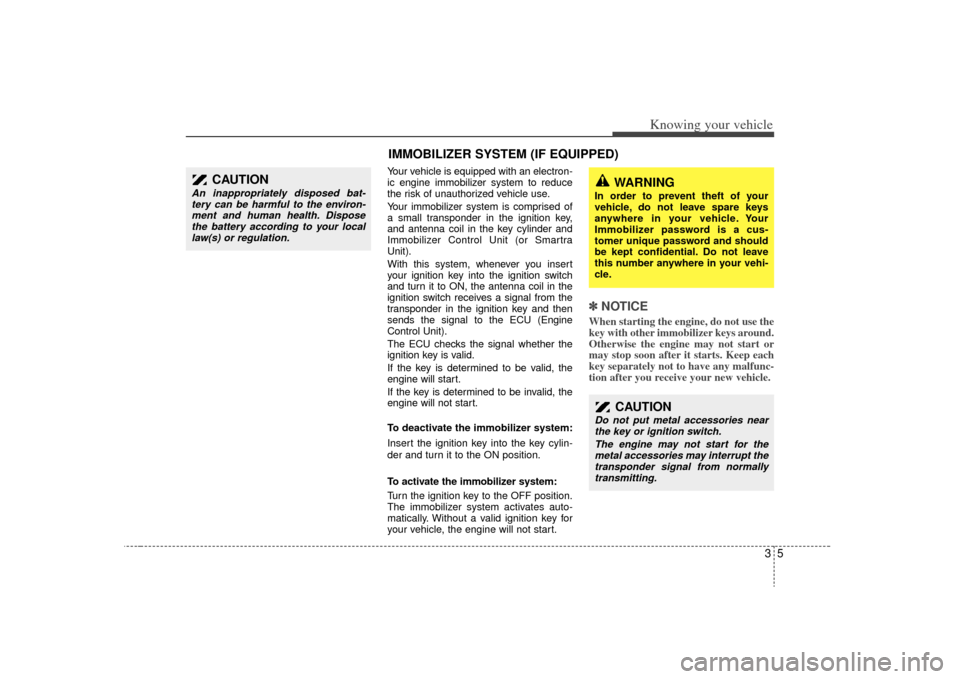
35
Knowing your vehicle
Your vehicle is equipped with an electron-
ic engine immobilizer system to reduce
the risk of unauthorized vehicle use.
Your immobilizer system is comprised of
a small transponder in the ignition key,
and antenna coil in the key cylinder and
Immobilizer Control Unit (or Smartra
Unit).
With this system, whenever you insert
your ignition key into the ignition switch
and turn it to ON, the antenna coil in the
ignition switch receives a signal from the
transponder in the ignition key and then
sends the signal to the ECU (Engine
Control Unit).
The ECU checks the signal whether the
ignition key is valid.
If the key is determined to be valid, the
engine will start.
If the key is determined to be invalid, the
engine will not start.
To deactivate the immobilizer system:
Insert the ignition key into the key cylin-
der and turn it to the ON position.
To activate the immobilizer system:
Turn the ignition key to the OFF position.
The immobilizer system activates auto-
matically. Without a valid ignition key for
your vehicle, the engine will not start.
✽ ✽NOTICEWhen starting the engine, do not use the
key with other immobilizer keys around.
Otherwise the engine may not start or
may stop soon after it starts. Keep each
key separately not to have any malfunc-
tion after you receive your new vehicle.
CAUTION
Do not put metal accessories near
the key or ignition switch.
The engine may not start for themetal accessories may interrupt the transponder signal from normallytransmitting.
WARNING
In order to prevent theft of your
vehicle, do not leave spare keys
anywhere in your vehicle. Your
Immobilizer password is a cus-
tomer unique password and should
be kept confidential. Do not leave
this number anywhere in your vehi-
cle.
CAUTION
An inappropriately disposed bat-tery can be harmful to the environ- ment and human health. Disposethe battery according to your locallaw(s) or regulation.
IMMOBILIZER SYSTEM (IF EQUIPPED)
Page 16 of 327
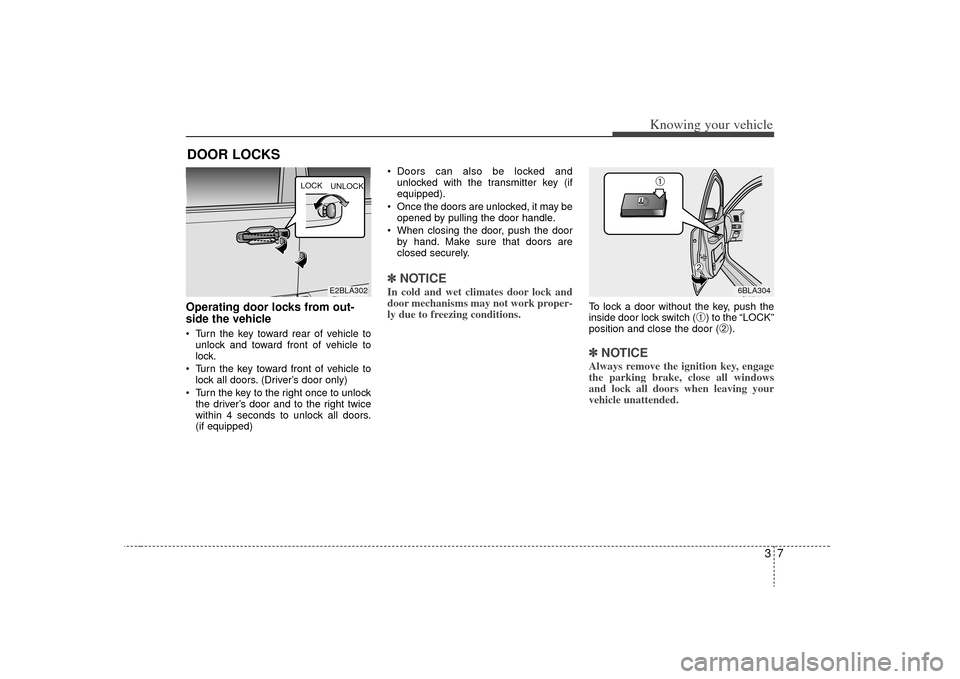
37
Knowing your vehicle
Operating door locks from out-
side the vehicle Turn the key toward rear of vehicle tounlock and toward front of vehicle to
lock.
Turn the key toward front of vehicle to lock all doors. (Driver’s door only)
Turn the key to the right once to unlock the driver’s door and to the right twice
within 4 seconds to unlock all doors.
(if equipped) Doors can also be locked and
unlocked with the transmitter key (if
equipped).
Once the doors are unlocked, it may be opened by pulling the door handle.
When closing the door, push the door by hand. Make sure that doors are
closed securely.
✽ ✽ NOTICEIn cold and wet climates door lock and
door mechanisms may not work proper-
ly due to freezing conditions.
To lock a door without the key, push the
inside door lock switch (
➀) to the “LOCK”
position and close the door (
➁).
✽ ✽ NOTICEAlways remove the ignition key, engage
the parking brake, close all windows
and lock all doors when leaving your
vehicle unattended.
DOOR LOCKS
E2BLA302
LOCK
UNLOCK
6BLA304
➀
➁
Page 20 of 327
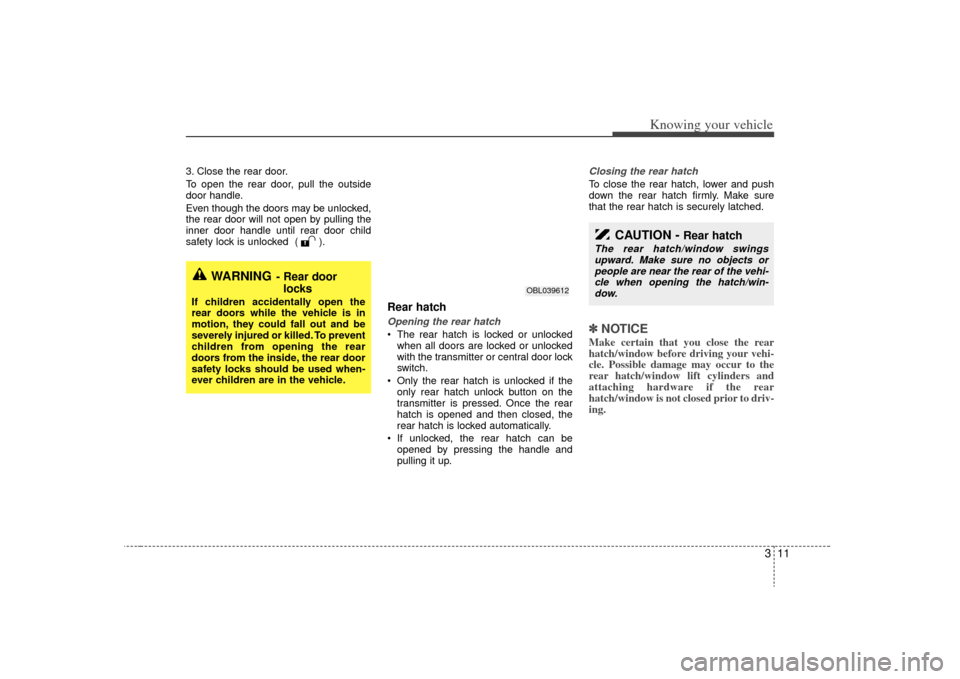
311
Knowing your vehicle
3. Close the rear door.
To open the rear door, pull the outside
door handle.
Even though the doors may be unlocked,
the rear door will not open by pulling the
inner door handle until rear door child
safety lock is unlocked ( ).
Rear hatchOpening the rear hatch The rear hatch is locked or unlockedwhen all doors are locked or unlocked
with the transmitter or central door lock
switch.
Only the rear hatch is unlocked if the only rear hatch unlock button on the
transmitter is pressed. Once the rear
hatch is opened and then closed, the
rear hatch is locked automatically.
If unlocked, the rear hatch can be opened by pressing the handle and
pulling it up.
Closing the rear hatchTo close the rear hatch, lower and push
down the rear hatch firmly. Make sure
that the rear hatch is securely latched.✽ ✽ NOTICEMake certain that you close the rear
hatch/window before driving your vehi-
cle. Possible damage may occur to the
rear hatch/window lift cylinders and
attaching hardware if the rear
hatch/window is not closed prior to driv-
ing.
WARNING
- Rear door
locks
If children accidentally open the
rear doors while the vehicle is in
motion, they could fall out and be
severely injured or killed. To prevent
children from opening the rear
doors from the inside, the rear door
safety locks should be used when-
ever children are in the vehicle.
CAUTION -
Rear hatch
The rear hatch/window swings
upward. Make sure no objects or people are near the rear of the vehi-cle when opening the hatch/win-dow.
OBL039612
Page 21 of 327
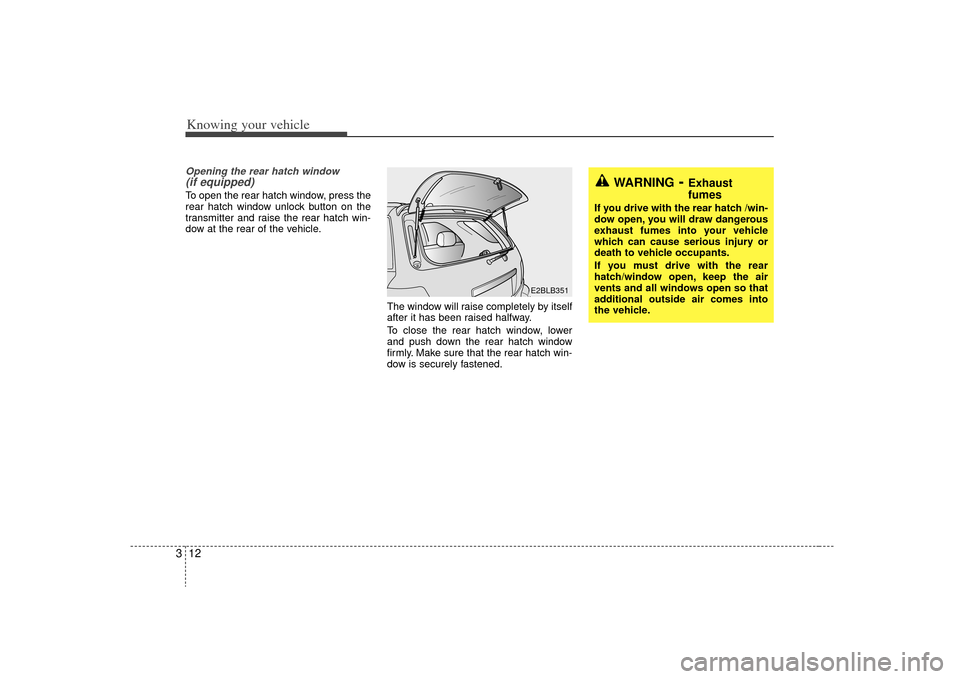
Knowing your vehicle12
3Opening the rear hatch window(if equipped)To open the rear hatch window, press the
rear hatch window unlock button on the
transmitter and raise the rear hatch win-
dow at the rear of the vehicle.
The window will raise completely by itself
after it has been raised halfway.
To close the rear hatch window, lower
and push down the rear hatch window
firmly. Make sure that the rear hatch win-
dow is securely fastened.
WARNING
- Exhaust
fumes
If you drive with the rear hatch /win-
dow open, you will draw dangerous
exhaust fumes into your vehicle
which can cause serious injury or
death to vehicle occupants.
If you must drive with the rear
hatch/window open, keep the air
vents and all windows open so that
additional outside air comes into
the vehicle.
E2BLB351
Page 25 of 327
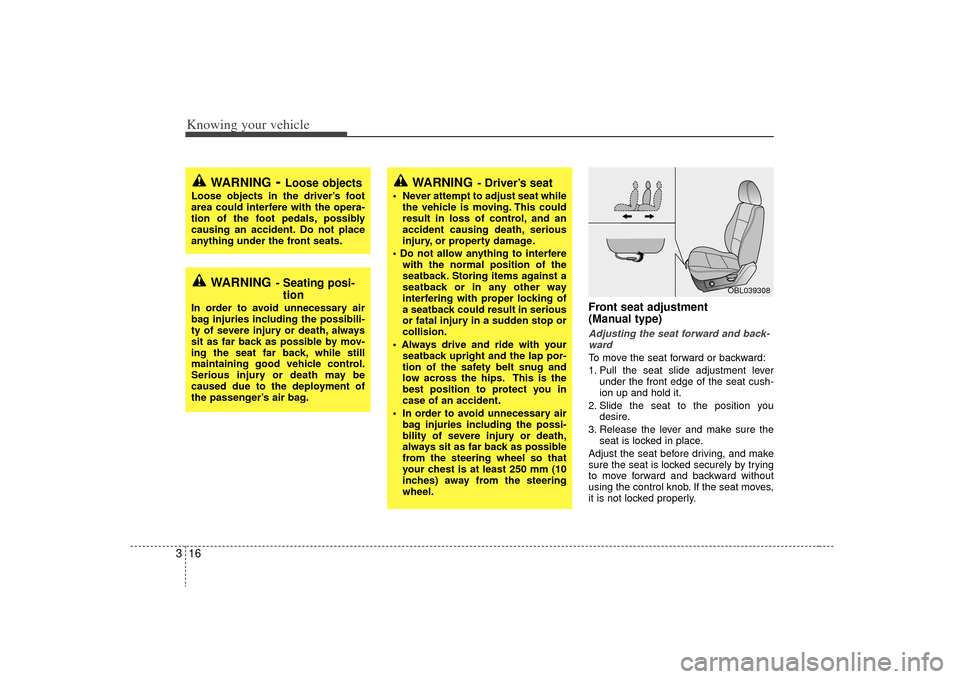
Knowing your vehicle16
3
Front seat adjustment
(Manual type)Adjusting the seat forward and back-
wardTo move the seat forward or backward:
1. Pull the seat slide adjustment lever under the front edge of the seat cush-
ion up and hold it.
2. Slide the seat to the position you desire.
3. Release the lever and make sure the seat is locked in place.
Adjust the seat before driving, and make
sure the seat is locked securely by trying
to move forward and backward without
using the control knob. If the seat moves,
it is not locked properly.
WARNING
- Loose objects
Loose objects in the driver’s foot
area could interfere with the opera-
tion of the foot pedals, possibly
causing an accident. Do not place
anything under the front seats.
WARNING
- Driver’s seat
Never attempt to adjust seat while the vehicle is moving. This could
result in loss of control, and an
accident causing death, serious
injury, or property damage.
with the normal position of the
seatback. Storing items against a
seatback or in any other way
interfering with proper locking of
a seatback could result in serious
or fatal injury in a sudden stop or
collision.
seatback upright and the lap por-
tion of the safety belt snug and
low across the hips. This is the
best position to protect you in
case of an accident.
In order to avoid unnecessary air bag injuries including the possi-
bility of severe injury or death,
always sit as far back as possible
from the steering wheel so that
your chest is at least 250 mm (10
inches) away from the steering
wheel.
WARNING
- Seating posi-tion
In order to avoid unnecessary air
bag injuries including the possibili-
ty of severe injury or death, always
sit as far back as possible by mov-
ing the seat far back, while still
maintaining good vehicle control.
Serious injury or death may be
caused due to the deployment of
the passenger’s air bag.
OBL039308
Page 27 of 327
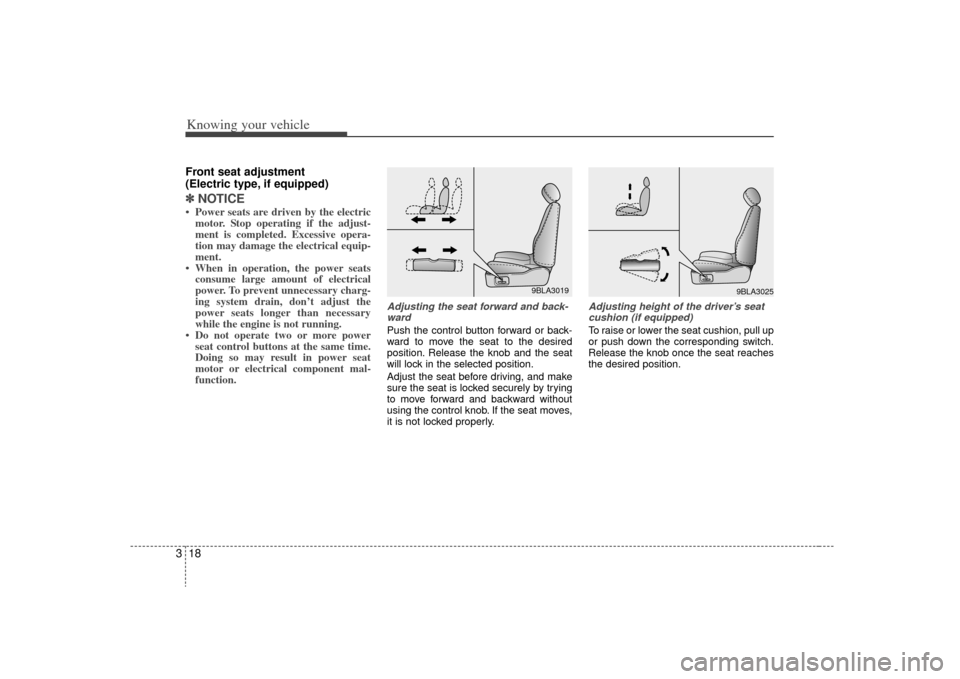
Knowing your vehicle18
3Front seat adjustment
(Electric type, if equipped)✽ ✽
NOTICE• Power seats are driven by the electric
motor. Stop operating if the adjust-
ment is completed. Excessive opera-
tion may damage the electrical equip-
ment.
• When in operation, the power seats consume large amount of electrical
power. To prevent unnecessary charg-
ing system drain, don’t adjust the
power seats longer than necessary
while the engine is not running.
• Do not operate two or more power seat control buttons at the same time.
Doing so may result in power seat
motor or electrical component mal-
function.
Adjusting the seat forward and back-
wardPush the control button forward or back-
ward to move the seat to the desired
position. Release the knob and the seat
will lock in the selected position.
Adjust the seat before driving, and make
sure the seat is locked securely by trying
to move forward and backward without
using the control knob. If the seat moves,
it is not locked properly.
Adjusting height of the driver’s seatcushion (if equipped)To raise or lower the seat cushion, pull up
or push down the corresponding switch.
Release the knob once the seat reaches
the desired position.
9BLA3019
9BLA3025
Page 33 of 327
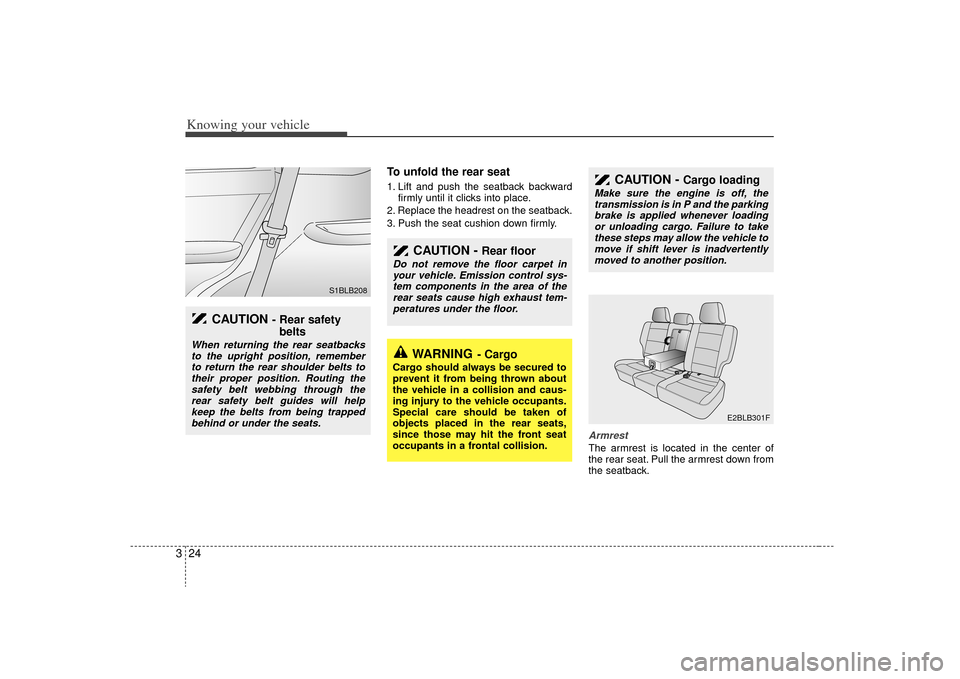
Knowing your vehicle24
3
To unfold the rear seat1. Lift and push the seatback backward
firmly until it clicks into place.
2. Replace the headrest on the seatback.
3. Push the seat cushion down firmly.
ArmrestThe armrest is located in the center of
the rear seat. Pull the armrest down from
the seatback.
CAUTION -
Rear floor
Do not remove the floor carpet in your vehicle. Emission control sys- tem components in the area of therear seats cause high exhaust tem-peratures under the floor.
WARNING
- Cargo
Cargo should always be secured to
prevent it from being thrown about
the vehicle in a collision and caus-
ing injury to the vehicle occupants.
Special care should be taken of
objects placed in the rear seats,
since those may hit the front seat
occupants in a frontal collision.
CAUTION -
Cargo loading
Make sure the engine is off, thetransmission is in P and the parking brake is applied whenever loadingor unloading cargo. Failure to take these steps may allow the vehicle tomove if shift lever is inadvertentlymoved to another position.
E2BLB301F
CAUTION
- Rear safety belts
When returning the rear seatbacks
to the upright position, remember to return the rear shoulder belts totheir proper position. Routing thesafety belt webbing through the rear safety belt guides will helpkeep the belts from being trappedbehind or under the seats.
S1BLB208
Page 37 of 327
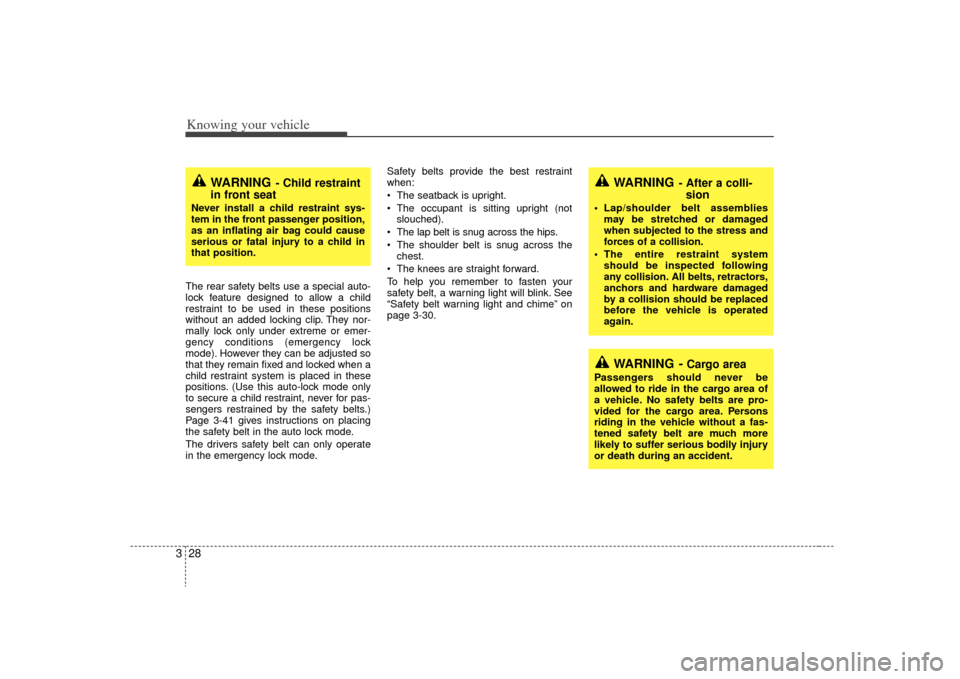
Knowing your vehicle28
3The rear safety belts use a special auto-
lock feature designed to allow a child
restraint to be used in these positions
without an added locking clip. They nor-
mally lock only under extreme or emer-
gency conditions (emergency lock
mode). However they can be adjusted so
that they remain fixed and locked when a
child restraint system is placed in these
positions. (Use this auto-lock mode only
to secure a child restraint, never for pas-
sengers restrained by the safety belts.)
Page 3-41 gives instructions on placing
the safety belt in the auto lock mode.
The drivers safety belt can only operate
in the emergency lock mode. Safety belts provide the best restraint
when:
The seatback is upright.
The occupant is sitting upright (not
slouched).
The lap belt is snug across the hips.
The shoulder belt is snug across the chest.
The knees are straight forward.
To help you remember to fasten your
safety belt, a warning light will blink. See
“Safety belt warning light and chime” on
page 3-30.
WARNING
- Child restraint
in front seat
Never install a child restraint sys-
tem in the front passenger position,
as an inflating air bag could cause
serious or fatal injury to a child in
that position.
WARNING
- After a colli- sion
Lap/shoulder belt assemblies
may be stretched or damaged
when subjected to the stress and
forces of a collision.
The entire restraint system should be inspected following
any collision. All belts, retractors,
anchors and hardware damaged
by a collision should be replaced
before the vehicle is operated
again.
WARNING -
Cargo area
Passengers should never be
allowed to ride in the cargo area of
a vehicle. No safety belts are pro-
vided for the cargo area. Persons
riding in the vehicle without a fas-
tened safety belt are much more
likely to suffer serious bodily injury
or death during an accident.
Page 42 of 327
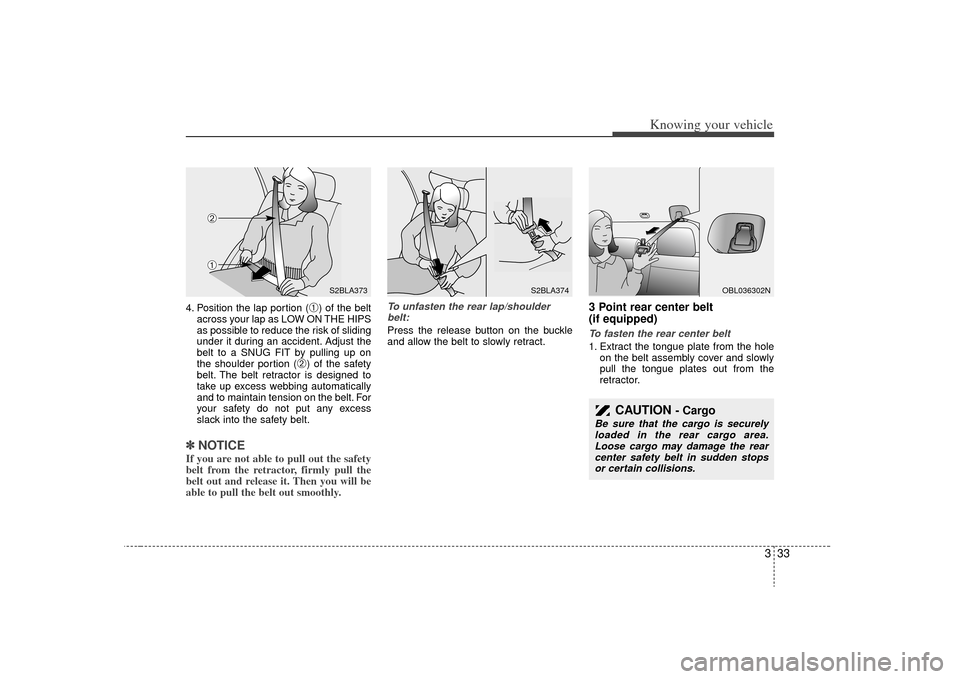
333
Knowing your vehicle
4. Position the lap portion (
➀) of the belt
across your lap as LOW ON THE HIPS
as possible to reduce the risk of sliding
under it during an accident. Adjust the
belt to a SNUG FIT by pulling up on
the shoulder portion (
➁) of the safety
belt. The belt retractor is designed to
take up excess webbing automatically
and to maintain tension on the belt. For
your safety do not put any excess
slack into the safety belt.
✽ ✽ NOTICEIf you are not able to pull out the safety
belt from the retractor, firmly pull the
belt out and release it. Then you will be
able to pull the belt out smoothly.
To unfasten the rear lap/shoulder
belt:Press the release button on the buckle
and allow the belt to slowly retract.
3 Point rear center belt
(if equipped) To fasten the rear center belt1. Extract the tongue plate from the hole on the belt assembly cover and slowly
pull the tongue plates out from the
retractor.
CAUTION
- Cargo
Be sure that the cargo is securelyloaded in the rear cargo area. Loose cargo may damage the rearcenter safety belt in sudden stopsor certain collisions.
OBL036302N
S2BLA374
S2BLA373
➀➁
Page 48 of 327
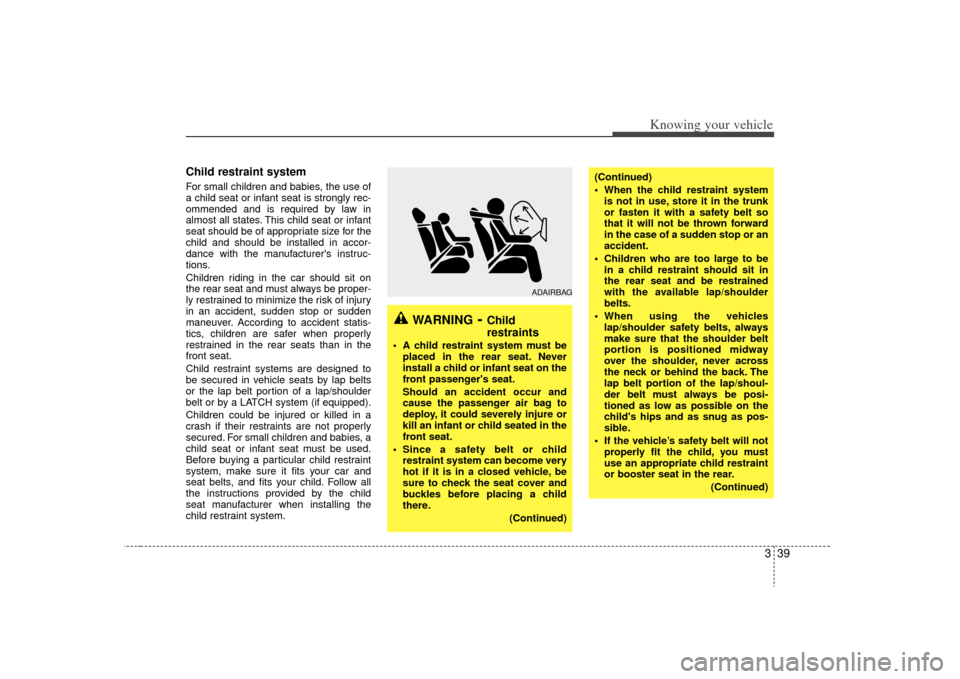
339
Knowing your vehicle
Child restraint system For small children and babies, the use of
a child seat or infant seat is strongly rec-
ommended and is required by law in
almost all states. This child seat or infant
seat should be of appropriate size for the
child and should be installed in accor-
dance with the manufacturer's instruc-
tions.
Children riding in the car should sit on
the rear seat and must always be proper-
ly restrained to minimize the risk of injury
in an accident, sudden stop or sudden
maneuver. According to accident statis-
tics, children are safer when properly
restrained in the rear seats than in the
front seat.
Child restraint systems are designed to
be secured in vehicle seats by lap belts
or the lap belt portion of a lap/shoulder
belt or by a LATCH system (if equipped).
Children could be injured or killed in a
crash if their restraints are not properly
secured. For small children and babies, a
child seat or infant seat must be used.
Before buying a particular child restraint
system, make sure it fits your car and
seat belts, and fits your child. Follow all
the instructions provided by the child
seat manufacturer when installing the
child restraint system.
WARNING
- Child
restraints
A child restraint system must beplaced in the rear seat. Never
install a child or infant seat on the
front passenger's seat.
Should an accident occur and
cause the passenger air bag to
deploy, it could severely injure or
kill an infant or child seated in the
front seat.
Since a safety belt or child restraint system can become very
hot if it is in a closed vehicle, be
sure to check the seat cover and
buckles before placing a child
there.
(Continued)
(Continued)
When the child restraint systemis not in use, store it in the trunk
or fasten it with a safety belt so
that it will not be thrown forward
in the case of a sudden stop or an
accident.
Children who are too large to be in a child restraint should sit in
the rear seat and be restrained
with the available lap/shoulder
belts.
When using the vehicles lap/shoulder safety belts, always
make sure that the shoulder belt
portion is positioned midway
over the shoulder, never across
the neck or behind the back. The
lap belt portion of the lap/shoul-
der belt must always be posi-
tioned as low as possible on the
child's hips and as snug as pos-
sible.
If the vehicle’s safety belt will not properly fit the child, you must
use an appropriate child restraint
or booster seat in the rear.
(Continued)
ADAIRBAG